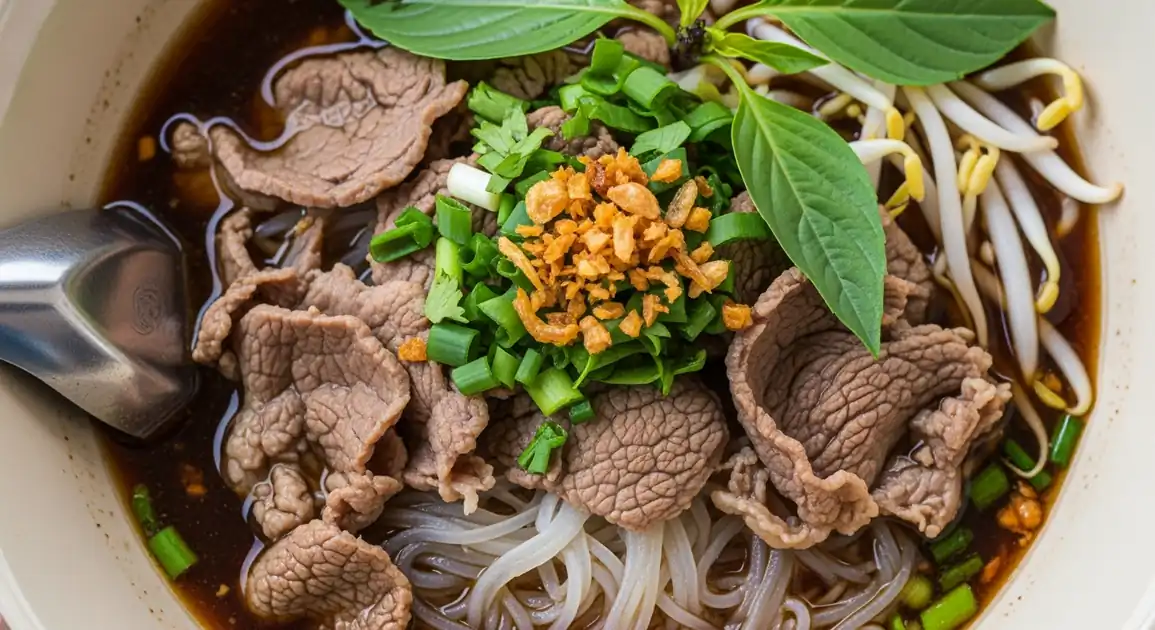Beef Noodle Soup
ก๋วยเตี๋ยวเนื้อ (Kuay Teow Neua)

Description
Bangkok offers the widest variety of beef noodle soup styles in Thailand, from humble street carts to specialized shophouses with generations of expertise. The capital's version typically features a well-balanced, aromatic broth with Chinese influences. Particular areas like Victory Monument (boat noodles) and Yaowarat (Chinatown) are famous for their distinctive beef noodle styles.
Dietary Information
Serving information
Serving style
Served in ceramic or metal bowls with condiment caddy containing sugar, fish sauce, dried chili flakes, and vinegar with chilies. Bangkok vendors often provide extra herbs and bean sprouts on a separate plate.
Quick facts
Street vendors typically operate 7 AM - 2 PM or until sold out. Shophouse restaurants often open 10 AM - 8 PM. Boat noodle specialists may run 11 AM - 9 PM. Mall food court vendors follow mall hours (typically 10 AM - 9 PM).
Safety Tips
What to Look For
-
Rapidly boiling broth at cooking station
The broth must be kept at a rolling boil to ensure safe cooking temperatures that kill potential pathogens, especially important for meat products.
-
Fresh meat stored properly (refrigerated or on ice)
Raw beef should be kept cold until cooking. Look for vendors who slice meat to order or keep it refrigerated/on ice rather than at ambient temperature.
-
Busy vendors with high customer turnover
Popular stalls with consistent customer flow ensure ingredients are used quickly and broth is replenished regularly, reducing food safety risks.
-
Separate utensils for raw and cooked ingredients
Vendors should use different tools for handling raw meat versus serving cooked food to prevent cross-contamination.
What to avoid
-
Pre-cooked meat sitting at ambient temperature
Cooked beef stored at room temperature for extended periods can harbor harmful bacteria. Meat should either be kept in hot broth or refrigerated.
-
Lukewarm or barely simmering broth
Broth that isn't hot enough won't properly cook raw ingredients or kill potential pathogens. Look for visibly boiling broth.
-
Dirty preparation surfaces or utensils
Unclean cutting boards, knives, or serving implements can introduce contaminants. Overall stall cleanliness is a good indicator of food safety practices.
-
Condiments with visible contamination or left uncovered
Table condiments exposed to flies or without covers can be sources of contamination. Look for covered containers and clean serving spoons.
Price information
Price range
Budget tips
- Street vendors in residential areas offer better value (50-70 THB) than tourist areas.
- Small boat noodle portions cost 40-60 THB, but typically require 3-5 bowls for a full meal.
- Some famous vendors charge premium prices (100-150 THB) but offer exceptional quality beef.
- Avoid tourist-oriented areas like Khaosan Road where prices are inflated.
- Ordering 'nam sai' (clear broth) version is often cheaper than specialty broths.
Value indicators
- Generous meat-to-noodle ratio with tender beef slices.
- Broth with depth and clarity, not overly salty or MSG-heavy.
- Complimentary extras like herbs, bean sprouts, and broth refills.
- Hand-sliced beef rather than pre-sliced commercial meat.
- House-made beef balls rather than commercial varieties.
Where to Find This Dish
Victory Monument
Famous for boat noodle alleys with dozens of specialized vendors serving smaller portioned, richer beef noodle soups.
Victory Monument, Soi Rangnam, Boat Noodle Alley
Lunch, Dinner
Yaowarat (Chinatown)
Home to some of Bangkok's oldest beef noodle vendors with distinctive Chinese-influenced recipes and cooking techniques.
Yaowarat Road, Charoen Krung, Plaeng Nam Road
Lunch, Evening
Sukhumvit Area
Mix of street vendors and shophouse restaurants catering to both locals and expatriates with varying spice levels.
Sukhumvit Soi 38, Thonglor, Ekkamai
Lunch, Dinner
Rattanakosin (Old City)
Traditional vendors with recipes passed down through generations, some operating for over 50 years.
Dinso Road, Tanao Road, Phraeng Phuthon
Morning, Lunch
Vendor Tips
- Vendors displaying certification or food safety stickers from Bangkok Metropolitan Administration typically maintain higher hygiene standards.
- Specialization is key - vendors offering many different noodle types might not excel at beef broth.
- Look for vendors who actually make their own beef balls rather than using commercial ones.
- Vendors whose broths smell strongly of star anise and cinnamon typically offer more authentic Chinese-influenced versions.
How to Order
Regional Variations
-
Bangkok-style Beef Noodles
(ก๋วยเตี๋ยวเนื้อแบบกรุงเทพ)
The classic Bangkok style features a clear, aromatic broth with balanced spices and moderate sweetness. Typically includes sliced beef, beef balls, and sometimes tripe or tendon.
-
Victory Monument Boat Noodles
(ก๋วยเตี๋ยวเรืออนุสาวรีย์)
Famous specialty around Victory Monument featuring small bowls with dark, rich broth traditionally containing beef blood for thickness. Garnished with pork crackling and served with various beef parts.
-
Chinatown Beef Brisket Noodles
(ก๋วยเตี๋ยวเนื้อตุ๋นเยาวราช)
Yaowarat (Chinatown) specializes in tender braised beef brisket noodles with strong Chinese influences including five-spice and prominent star anise notes.
-
Halal Beef Noodles
(ก๋วยเตี๋ยวเนื้อฮาลาล)
Muslim-friendly versions found around Haroon Mosque and Bangrak areas, featuring halal-certified beef and no fish sauce, often with distinct spice profiles.
Cultural context
History
Beef noodle soup in Thailand represents the significant Chinese culinary influence, particularly from Teochew immigrants who brought noodle soup techniques in the late 18th and 19th centuries. The dish evolved by incorporating Thai flavors and local ingredients, becoming a staple of street food culture. Various regional styles developed, with Central Thailand versions featuring clearer broths and Bangkok vendors creating distinctive variations. The related 'boat noodles' originated from canal-based vendors in central Thailand who served concentrated, smaller portions from boats.
Local significance
In Bangkok, beef noodle soup reflects the city's multicultural heritage, particularly Chinese influences. It's considered an everyday dish that crosses social boundaries, enjoyed by everyone from taxi drivers to office workers to students.
Eating customs
- Bangkok locals typically taste the broth first before customizing with condiments.
- The proper technique uses spoon in dominant hand, chopsticks in the other.
- Bean sprouts are sometimes added to the hot soup to slightly cook them, or kept separate for crunch.
- Many locals judge a beef noodle shop primarily on its broth clarity and flavor.